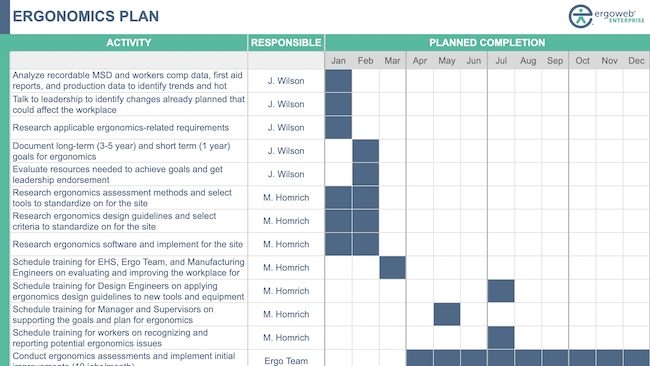Managing ergonomics at a site requires a lot of planning, coordination, and communication. An effective ergonomics improvement initiative relies on contributions of people throughout the organization – ergonomics is a problem solving process, and different workplace conditions require different functions to be engaged in implementing workplace improvements.
A team leader might be the right person to order a swivel hose coupling for a pneumatic tool, while a maintenance person will likely be required to fabricate a new handle that provides for a power grip on a heavy fixture. Complex changes that affect a product or production process will likely impact a number of functions including engineering, finance, and site leadership. If your site has a Lean or Six Sigma team, they might be tasked with making changes to the workplace that can address ergonomic issues.
So where do you start if you’ve been assigned the role of site ergonomics process leader? That depends on the decisions that have already been made at the corporate- or division-level. Some companies standardize on ergonomics assessment methods, software, design guidelines, training, metrics, and roles and responsibilities. If your company has an ergonomics policy/standard that defines these aspects, you can move on to developing your site ergonomics plan. But if these have not been determined for you, you’ll have to make your own choices.
Developing a Site Ergonomics Plan
A common mistake we see in all types of industry is not properly setting the stage for the ergonomics improvement process. Workplace ergonomics is not a training initiative or an assessment initiative, it’s an improvement process.
Too often, companies start by training an ergonomics team and embarking on an aggressive ergonomics assessment campaign. By year end, they are able to report that an impressive number of jobs have been assessed for ergonomics risk, but very few workplace improvements have been implemented to reduce the risk. Everyone involved is frustrated and support for the ergonomics initiative wanes.
The missing piece is getting leadership support up-front for implementing workplace improvements and buy-in for ergonomics improvement goals. We recommend the following steps:
- Understand your “current state”. What ergonomics-related requirements apply (corporate standards, government regulations, etc.)? What changes are planned at your site that may impact the workplace (new products, capital improvements, etc.)?
- Gain leadership endorsement of the desired “future state”. Develop concrete goals for training, assessing, and improving ergonomics. Detail the resources needed to achieve the goals – especially human resources (roles and responsibilities).
- Translate the goals into specific actions over the next 12 months. When you’re first starting, a well defined training plan for individuals with roles and responsibilities for ergonomics will be important.
- Get leadership feedback on your plan. Once everyone is on board, you can move forward knowing that you will get the support to be successful.
Download Ergoweb’s Ergonomics Planning Template to help develop your annual ergonomics plan. It provides examples and blank templates for the key steps outlined above.

Screenshot from an example ergonomics plan using Ergoweb’s Ergonomics Planning Template.
Also download Ergoweb’s free 14 page guide, 5 Essential Elements of a Successful Ergonomics Process for lessons learned from companies with well managed ergonomics processes.
